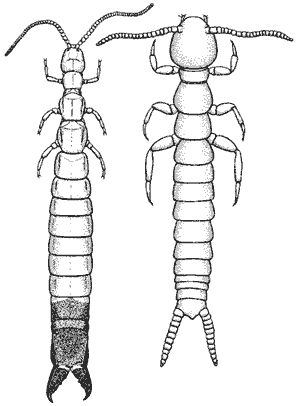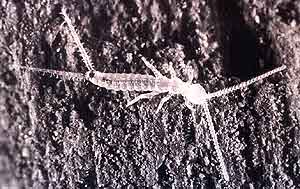|
Diplura
Characteristics
Like many of the entognathous
hexapods, most diplurans are very small and usually less than 5
millimetres in length. Some species however are known to grow up
to 50 millimetres. Some diplurans especially the larger species
are sometime mistaken for earwigs
(Dermaptera)
due to their cerci,
which sometimes appear darkened and pincer-like. Earwigs and diplurans
can be distinguished from one another as the latter have no eyes.
Diplurans have the following characteristics:
|

Heterojapyx evansi (JAPYGIDAE)
and Symphylurius species (PROJAPYGIDAE)
|
|
|
- Narrow, elongate
body, usually colourless
- 2 abdominal
cerci
sometimes in the form of darker coloured pincers
The species in the JAPYGIDAE family vary greatly in size but all
can be recognised by their pincer-like cerci.
Heterojapyx species are the most distinctive due to their robust
appearance. Species within PROJAPYGIDAE can be distinguished by
their larger heads and short thick cerci,
which contain silk glands. Of the 2 known Australian species Symphylurius
are considered rare.
Life Cycle
Fertilisation
is similar to that of collembolans where a spermatophore
is deposited on the substrate to be taken by a female. The female
then lays her eggs in clumps in rotting vegetation or in crevices
in the soil. Some species are known to guard the eggs and young
larvae. Development is slow and the young diplurans resemble adults.
Moulting continues throughout life and an adult may moult up to
30 times during its relatively short life of up to 1 year.
Feeding
Most species
of diplurans are herbivores
and feed on a wide variety of plant matter. Those species with pincer-like
cerci
are carnivorous
and wait buried in the soil with their tail on the surface and grab
any small arthropods that come in contact with their forceps.
Habitat
Most diplurans
appear to be more common in the wetter forests of Australia. They
are often found in small groups or colonies in the soil, in mosses
and under rocks, logs or the bark of trees. A few species have also
been found in the nests of ants and termites.
|

Campodea
species (CAMPODEIDAE)
|
|